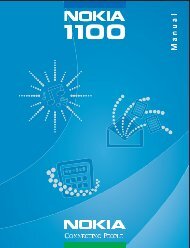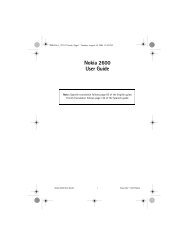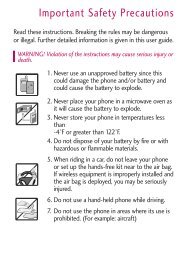You also want an ePaper? Increase the reach of your titles
YUMPU automatically turns print PDFs into web optimized ePapers that Google loves.
SAFETY<br />
30<br />
SAFETY<br />
that limit Radio Frequency (RF) energy exposures. The<br />
FCC established these guidelines in consultation with<br />
the FDA and the other federal health and safety<br />
agencies. The FCC limit for RF exposure from wireless<br />
phones is set at a Specific Absorption Rate (SAR) of<br />
1.6 watts per kilogram (1.6 W/kg). The FCC limit is<br />
consistent with the safety standards developed by the<br />
Institute of Electrical and Electronic Engineering (IEEE)<br />
and the National Council on Radiation Protection and<br />
Measurement. The exposure limit takes into<br />
consideration the body’s ability to remove heat from<br />
the tissues that absorb energy from the wireless<br />
phone and is set well below levels known to have<br />
effects. Manufacturers of wireless phones must report<br />
the RF exposure level for each model of phone to the<br />
FCC. The FCC website<br />
(http://www.fcc.gov/oet/rfsafety) gives directions for<br />
locating the FCC identification number on your phone<br />
so you can find your phone’s RF exposure level in the<br />
online listing.<br />
8. What has the FDA done to measure the<br />
Radio Frequency energy coming from<br />
wireless phones?<br />
The Institute of Electrical and Electronic Engineers<br />
(IEEE) is developing a technical standard for<br />
measuring the Radio Frequency (RF) energy exposure<br />
from wireless phones and other wireless handsets with<br />
the participation and leadership of FDA scientists and<br />
engineers. The standard, “Recommended Practice for<br />
Determining the Spatial-Peak Specific Absorption Rate<br />
(SAR) in the Human Body Due to Wireless<br />
Communications Devices: Experimental Techniques”,<br />
sets forth the first consistent test methodology for<br />
measuring the rate at which RF is deposited in the<br />
heads of wireless phone users. The test method uses a<br />
tissue-simulating model of the human head.<br />
Standardized SAR test methodology is expected to<br />
greatly improve the consistency of measurements<br />
made at different laboratories on the same phone.<br />
SAR is the measurement of the amount of energy<br />
absorbed in tissue, either by the whole body or a<br />
small part of the body. It is measured in watts/kg (or<br />
milliwatts/g) of matter. This measurement is used to<br />
determine whether a wireless phone complies with<br />
safety guidelines.<br />
9. What steps can I take to reduce my<br />
exposure to Radio Frequency energy from<br />
my wireless phone?<br />
If there is a risk from these products — and at this<br />
point we do not know that there is — it is probably<br />
very small. But if you are concerned about avoiding<br />
even potential risks, you can take a few simple steps to<br />
minimize your exposure to Radio Frequency (RF)<br />
energy. Since time is a key factor in how much<br />
exposure a person receives, reducing the amount of<br />
time spent using a wireless phone will reduce RF<br />
exposure. If you must conduct extended conversations<br />
by wireless phone every day, you could place more<br />
distance between your body and the source of the RF,<br />
since the exposure level drops off dramatically with<br />
distance. For example, you could use a headset and<br />
carry the wireless phone away from your body or use<br />
a wireless phone connected to a remote antenna.<br />
Again, the scientific data do not demonstrate that<br />
wireless phones are harmful. But if you are concerned<br />
about the RF exposure from these products, you can<br />
use measures like those described above to reduce<br />
your RF exposure from wireless phone use.<br />
10. What about children using wireless<br />
phones?<br />
The scientific evidence does not show a danger to<br />
users of wireless phones, including children and<br />
teenagers. If you want to take steps to lower exposure<br />
to Radio Frequency (RF) energy, the measures<br />
described above would apply to children and









